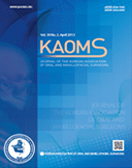Retrospective analysis of characteristics of patients presenting to the emergency room following dental treatment
- 대한구강악안면외과학회
- 대한구강악안면외과학회지
- 제50권 제6호
-
2024.12326 - 332 (7 pages)
-
DOI : 10.5125/jkaoms.2024.50.6.326
- 6

Objectives: This study is a retrospective analysis of patients who visited the emergency room (ER) following dental treatment over a period of 3 years, with the aim to enhance the understanding of emergency situations that may arise after dental procedures and to develop appropriate postoperative management and emergency care methods. Patients and Methods: A total of 796 emergency patients whose visits were attributed to dental procedures, of 4,241 patients who visited the ER at Pusan National University Yangsan Hospital from January 2021 to January 2024, was included in the study. Patients were categorized based on the reason for visit into bleeding, inflammation, and other categories. Analysis was conducted on variables such as types of dental treatment, underlying conditions, and emergency treatment methods using ER records. Results: Among the 796 patients, 68.4% (539 patients) were in the bleeding group, 27.7% (219 patients) in the inflammation group, and 4.8% (38 patients) in the other complications group. Among the bleeding group, there were no associations between postoperative bleeding and systemic diseases, antithrombotic medications, or dental treatments. In 36.2% of cases, compression hemostasis alone was sufficient to resolve the bleeding. In the inflammation group, 29% of the cases required extraoral incision and drainage as emergency treatment, while 53% of the cases required subsequent hospitalization. Factors associated with hospitalization included underlying diseases (especially diabetes mellitus), procedures on mandibular teeth (especially third molars), and age older than 30 years. Conclusion: Ensuring adequate hemostasis after dental procedures is essential regardless of the patient’s underlying medical conditions. Dentists must also educate patients on pressure hemostasis techniques. Patients with underlying medical conditions, such as diabetes, have a higher possibility of requiring hospitalization if inflammation occurs. Therefore, preventive measures against inflammation should be implemented in these patients.
I. Introduction
II. Patients and Methods
III. Results
IV. Discussion
V. Conclusion
References
(0)
(0)